| Article ID | Journal | Published Year | Pages | File Type |
|---|---|---|---|---|
| 1050367 | Landscape and Urban Planning | 2009 | 14 Pages |
Revealing spatially varying relationships between urban growth patterns and underlying determinants is important for better understanding local dimensions of urban development. Through a case study of Nanjing, China, we employ both global and local logistic regressions to model the probability of urban land expansion against a set of spatial variables. We found that compared with other fast growing coastal cities, Nanjing remains a relatively compact city. The orthodox logistic regression found the significance of proximity, neighborhood conditions, and urban agglomeration in urban land change. The logistic GWR significantly improves the global logistic regression model in terms of better model goodness-of-fit and lower level of spatial autocorrelation of residuals. More importantly, the local estimates of parameters of spatial variables enable us to investigate spatial variations of the influences of spatial variables on urban growth. We have found distinctive local patterns and effects of urban growth in Nanjing, shaped by local urban spatial and institutional structures. A probability surface of urban growth, which is generated from raster calculations among the parameter and variable surfaces, provides a clear scenario of urban growth patterns and can be useful for decision making. This study also shows the importance of policy studies and fieldwork in the interpretation of results generated from statistical and GIS modeling.
